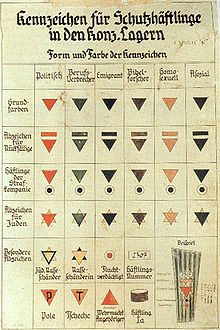Temporary preventive detention
Temporary preventive detention (BV) (also known as " Temporary preventive detention ") is an incorrect designation, also widely used in research literature, for a category of concentration camp inmates who were called "BV ler" or " professional criminal" in the camp jargon. The interpretation of the abbreviation "BV" as "Temporary preventive detention" is considered to be refuted.
term
The assertion that the "BV prisoners" were "Temporary Preventive Detainees" and that the abbreviation "BV-ler" resulted in the term "professional criminal" goes back to Eugen Kogon and his 1946 book Der SS-Staat - The system of the German concentration camps back. Its interpretation has been adopted in numerous representations by reputable historians.
As early as 1988, Wolfgang Ayaß pointed out that the designation "temporary preventive detention" cannot be proven in official decrees. In 1933 there was only preventive detention by the police , but it was unlimited. Julia Hörath regrets that Kogon's interpretation continues to spread uncritically despite repeated corrections. It can be proven that the correct designation of the type of detention is “preventive police custody” or “police preventive custody”; the term “Temporary Preventive Detention” can neither be proven before 1933 nor during the time of National Socialism . In November 1933, for example, a decree was issued on the “application of preventive police detention against professional criminals”; this deprivation of liberty was linked to an examination date, but in principle for an unlimited period. In the arrest warrants, the abbreviation "BV" stood for "professional criminal".
Hörath assumes that the camp staff falsely wrote the abbreviation as "Temporary preventive detention" "in ignorance of the current police vocabulary".
background
As early as 1933, multiple previous convictions had been taken into “preventive detention” and sent to concentration camps. However, this measure was limited to a few hundred people. In January 1937 Heinrich Himmler explained to Wehrmacht officers: “I am now, because crime is still too high for me in Germany, to lock up professional criminals on a much larger scale than before, after a few sentences, after three or four times, and not to let go more. ”Otherwise, this“ considerable number of insecure cantonists ”is the“ breeding ground for highly unpleasant developments in the event of a war ”.
In February 1937, Himmler ordered two thousand “professional and habitual criminals ” who were not permanently employed to be arrested and locked up in concentration camps. This action was carried out in March 1937. The number of "preventive prisoners" had thus quintupled.
According to Julia Hörath, this expansion of the functions of the concentration camps was not exclusively controlled centrally, but rather the idea of a genetically based “racial general prevention” gradually developed in the interplay between local and central authorities.
The "BVers" marked with a green triangle were often used as prison functionaries and were hated by the "political prisoners". In the late phase of the war , several “professional criminals” from the concentration camps were recruited for the SS special unit in Dirlewanger .
Under National Socialism, the prisoners interned in concentration camps were completely without rights. The protective custody , like the police preventive detention, was based on the Reichstag Fire Ordinance of February 28, 1933, which had suspended practically all individual basic rights , was never lifted by the National Socialists during their twelve-year dictatorship and remained the basis of their rule.
Research situation
In the research on the Nazi camp system was the role of the judicial police , which "both anti-social elements " as well briefed "professional criminals" as criminal prevention prisoners, long largely ignored. According to Ayass, the “Greens” are “probably the most poorly researched group of inmates”. Their social structure and life paths were not adequately investigated before their arrest. It is seldom known about their previous convictions whether they were serious crimes or several minor offenses. The classification of petty criminals as “professional criminals” or “work-shy anti-social workers” was partly left to chance.
According to Ayass, there is also a research desideratum in the numerical dimension. Whether the number of male German non-Jewish "political prisoners" exceeded that of "criminals" has not yet been researched.
Individual evidence
- ↑ Julia Hörath: Terror instrument of the "Volksgemeinschaft?" Concentration camp detention for "anti-social" and "professional criminals" 1933 to 1937/38. In: Zeitschrift für Geschichtsforschung 60 (2012), no. 6, p. 521. There books by Benz, Distel, Morsch, Orth and others are listed.
- ↑ Wolfgang Ayaß : "A requirement of the national work discipline." The action "Arbeitsscheu Reich" 1938. (Contributions to National Socialist Health and Social Policy Volume 6), Berlin 1988, p. 45, on the Internet, there p. 4 (PDF; 189 kB)
- ↑ Julia Hörath: Terror instrument of the "Volksgemeinschaft?" Concentration camp detention for "anti-social" and "professional criminals" 1933 to 1937/38. In: Zeitschrift für Geschichtsforschung 60 (2012), H. 6. S. 521.
- ↑ Peter Longerich : Heinrich Himmler: Biographie, Munich 2008, ISBN 978-3-88680-859-5 , p. 237 / In February 1934 there were 525 people - see Julia Hörath: Terrorinstrument der "Volksgemeinschaft?" KZ imprisonment for "Asocial" and "professional criminals" 1933 to 1937/38. In: Zeitschrift für Geschichtsforschung 60 (2012), no. 6, pp. 522–523.
- ^ Document 1992 (A) -PS in IMT: The Nuremberg Trial against the Major War Criminals ... , fotomech. Reprint Munich 1989, Vol. 29, ISBN 3-7735-2523-0 , pp. 220 and 222. - Comp. Peter Longerich: Heinrich Himmler: Biographie, Munich 2008, ISBN 978-3-88680-859-5 , p. 237.
- ^ Peter Longerich: Heinrich Himmler: Biographie, Munich 2008, ISBN 978-3-88680-859-5 , p. 237.
- ↑ Julia Hörath: Terror instrument of the "Volksgemeinschaft?" Concentration camp detention for "anti-social" and "professional criminals" 1933 to 1937/38. In: Zeitschrift für Geschichtsforschung 60 (2012), no. 6, pp. 531–532.
- ↑ Wolfgang Ayaß: Black and Green Angles. The National Socialist persecution of 'anti-socials' and 'criminals' - an overview of the history of research. In: Herbert Diercks (Red.): Excluded. 'Asocial and criminal' in the National Socialist camp system , Bremen 2009, ISBN 978-3-8378-4005-6 , pp. 24-25.
